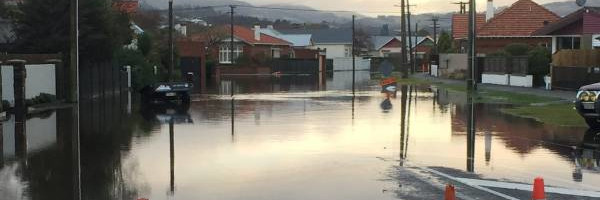Flood Abatement: Difference between revisions
en>Ocadmin No edit summary |
m 1 revision imported |
(No difference)
| |
Revision as of 20:44, October 31, 2021
| Flood Abatement | |
|---|---|

| |
 Surface flooding in Hargest Crescent on June 2015 in Dunedin. | |
| Team Organizations | NOKIA |
| Team Leaders | Sudipta Bhattacharyya Pre-Sales Solution Architecture Nokia |
| Participating Municipalities | Dunedin NZ |
| Status | Implemented |
| Document | [[File:Tech Jam Presentation|Download]] |
Description
Predict Flooding & provide safety to human life, Current Project in Dunedin, NZ
- Major flood event every year cause large amounts of residential and commercial damage
- A contributing factor to the flooding was blocked storm drains
- City responded by engaging a contract company to inspect and clean storm drains
- City has over 8000 storm drains within the city limits
Challenges
Clogged manholes, Rain Water catch basins, drain pipes cause blocking of water flow during rainy season leading to accumulation of water in low lands causing flood and damages in properties and quality of life.
Solutions
- Installation of Ultra Sonic water level sensors in the manholes, water inlets monitoring water level and reporting to City operation center via wireless connectivity
- The Dashboard provides information of water level which could be incorporated with the rain prediction for advance flood prediction
Major Requirements
- Installation of Sensors in the catch basis identified by city – work will be performed by City contractors & Sensor Calibration
- Hosting of IMPACT Nokia IoT Platform
- IMPACT South bound Adapter development to fetch, read and normalize data received from sensors
- IMPACT North bound adapter development to forward normalized sensor data to the Web Server (Application Server + database Server)
Update existing Dashboard application source code to show the data received from sensors and modification of User Interface of the dashboard.
Performance Targets
| Key Performance Indicators (KPIs) | Measurement Methods |
|---|---|
|
Water clogging in lowlands / streets reported by residents over one year |
Standards, Replicability, Scalability, and Sustainability
- Solution based on Ultra Sonic Measurement sensors with accuracy of 15 mm
- Telemetry sensor based on NB-IoT / CAT1M standard
Cybersecurity and Privacy
Cyber Security is provided by Nokia End User Security – anomaly detection and device management by Nokia IMPACT platform The Nokia IMPACT IoT Platform provides a highly secure system, audited by numerous large organizations, through three key elements: Platform access control Multi-tenanted system used to reflect the part of an organization within its group structure allows secure access to devices (gateways, aggregators, sensors, meters) Delegation allows assignment of secure user roles based on the security policy of the enterprise All passwords and other sensitive security information is encrypted internally within the database End-to-end chain of trust Security is provided along the whole processing chain and establishes trust with endpoints via: Two-way authentication Data privacy: multi-tenant Implements multi-tenancy by definition of groups, or domains. Adequate for both fixed and mobile devices: Devices registered on the platform are associated to a group based on policies and algorithms
Impacts
- Reduction of Flooding
- Improving quality of lives
Community acceptance to be replicated across the United States to engage the community to tie in medical resources
Demonstration/Deployment
Real-time working application tied into city operating center, preventative maintenance of the clogged manholes, catch basins before rain, reducing the accumulation of water in streets & low lands.